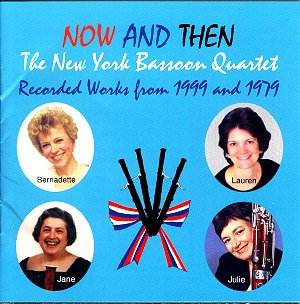Same-instrument ensembles can be very disappointing – multiple flutes
or oboes don’t work that well, though clarinets are much better, because
of the availability of bass and contrabass instruments. But multiple
bassoons can be quite wonderful, if the players can achieve blend, balance
and stylistic unity. All of those things the New York Bassoon Quartet
possess in generous quantities. It is quite a remarkable achievement
to have recorded two lots of music twenty years apart, with a rather
specialised ensemble such as this, and to produce such high quality
across all the tracks. They clearly all kept practising in the interim,
and this CD is a delight to listen to.
The bassoon quartet has a long and honourable history, which can be
traced all the way back to Michel Corrette’s Le Phoenix of the
mid-18th century. Nonetheless, it’s not surprising that all
of the works here come from the past thirty years or so, which is why
it was such a good idea to include the very tuneful and accessible arrangements
of traditional American melodies by Christopher Weait, himself a distinguished
player of the instrument. The attractive tunes are superbly arranged,
and the final jig, called ‘Captain Mulligan’, is well-nigh irresistible.
John Corigliano is possibly best known as a film composer – he wrote
the music, for example, for The Red Violin. Overlooking the perhaps
slightly pretentious title, this is a marvellous little piece, creating
surprising and original textures, particularly towards the ending, with
its wild upward rushing figuration.
The Prokofiev Humorous Scherzo is the best-known piece written
for this combination, and is delightful. I revelled in the contrast
between the bustling opening and the chorale-like passage that follows
at 0:51 (track 8). The quartet’s tuning here is outstanding.
It’s a close call, but for me, the Schuman pieces are the most musically
exciting items on the disc. The first one, Ostinato, has restless
triplets in the bass, while the upper parts have jagged staccato phrases.
Each of the four movements is tiny, none more than a minute or so, but
the textures and moods are vivid and compelling. This is a miniature
masterpiece, no less. John Harbison’s enjoyably gritty Canzonetta
completes the 1999 section of the recording.
The 1979 group begins with a piece by the redoubtable Peter Schickele
(a close relative of the great P.D.Q.Bach, of course), his profoundly
stirring Last Tango in Bayreuth. This transmogrification of Wagner’s
Tristan Prelude is one of Professor Schickele’s most brilliant
mickey-takes, turning the famous opening into the moodiest of tangos;
in fact, if listened to with all the objectivity one can muster, this
is really exquisite, though perfect Wagnerites will probably be too
busy having a seizure to appreciate its wonders. Lohengrin puts
in a welcome guest appearance, too.
The remaining tracks are all by modern American composers, all well
worth listening to. I found Katherine Hoover’s Sinfonia the finest,
indebted to Ravel, I think, at the start, but developing into an impressive
and powerful utterance.
If you are unfamiliar with music for this ensemble, then do give the
NYBQ a try. This is so very much more than a mere ‘novelty’ disc. There
is superb music here, with music-making and musicianship to match, all
captured flawlessly in this very fine recording.
Gwyn Parry-Jones

![]() for
details
for
details